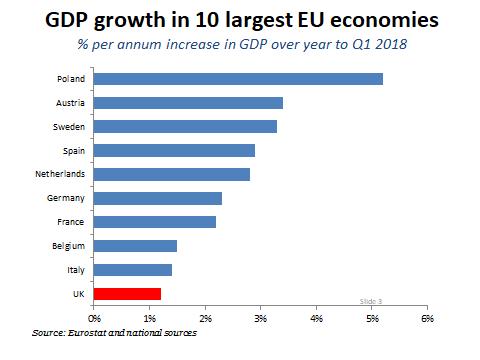UK economic growth has been revised up to 0.2% in the first quarter, as output from Britain’s construction sector came in higher than previously estimated.
Earlier readings of GDP by the Office for National Statistics (ONS) showed the economy grew just 0.1% – which would have been the slowest pace of growth in five years.
While the final reading means growth still halved from 0.4% in the final quarter of 2017, the slightly better measurement is likely to raise the prospect of a near-term interest rate hike by the Bank of England.
The ONS raised the figure in its final estimate after a notable upward revision in construction output, which mainly reflects improvements to the way the sector’s work is measured.
ONS head of GDP Rob Kent-Smith said: “GDP growth was revised up slightly in the first three months of 2018, with later construction data, and significantly improved methods for measuring the sector, nudging up growth.
“These improved methods, introduced as part of ONS’s annual update to its figures, will lead to better early estimates of the construction sector with smaller revisions in the future.”

The pound spiked in the wake of the data, rising 0.7% against the US dollar to trade at 1.317. Versus the euro, sterling was nearly flat, at 1.130.
Construction output growth was revised up by 1.9 percentage points over the quarter to negative 0.8%, while production output was revised down by 0.2 percentage points to 0.4%.
Services sector growth was unrevised at 0.3%.
The ONS reiterated that the overall impact of extreme wintry weather caused by the Beast from the East on output in the first quarter “appears to be relatively small.”
The Bank of England’s Monetary Policy Committee (MPC) now be watched closely for hints that an interest rate rise may be pushed through sooner rather later, with some voting members having previously held off following the sharp slowdown in growth.
Howard Archer, chief economic advisor at EY ITEM Club, said the upward revision to GDP, as well as the recent evidence of a pick-up in retail sales in the second quarter, “fuels our belief that the MPC is more likely than not to hike interest rates from 0.50% to 0.75% at their August meeting.”
“There is likely to be only one interest rate hike in 2018, leaving interest rates at 0.75% at the end of the year.
“We expect the Bank of England to raise interest rates twice in 2019 taking them up to 1.25% as it looks to gradually normalise monetary policy.”
Other ONS data showed the squeeze on living costs triggered by the collapse in the pound following the Brexit vote is easing.
Real household disposable income in the first quarter increased by 0.3% quarter on quarter, as wages increased at a faster rate than price rises.
It represents the second consecutive quarter of positive growth following over a year of negative growth.
However, the household saving ratio fell 0.4% to 4.1% as spending grew faster than income, the third-lowest quarterly saving ratio since records began in 1963.
Business investment was estimated to have fallen by 0.4% to £47.7 billion between the fourth and first quarter
The UK’s current account deficit was came in £17.7 billion, below forecasts of £18 billion, a narrowing of £1.8 billion from a revised deficit of £19.5 billion in the previous period.
Source: BT.com

